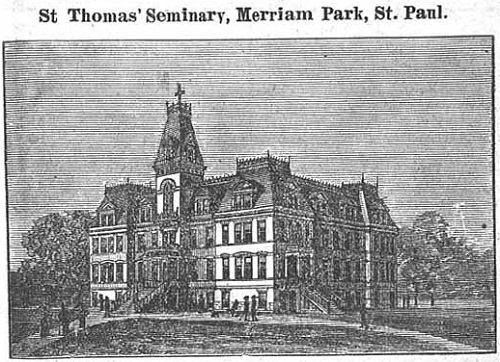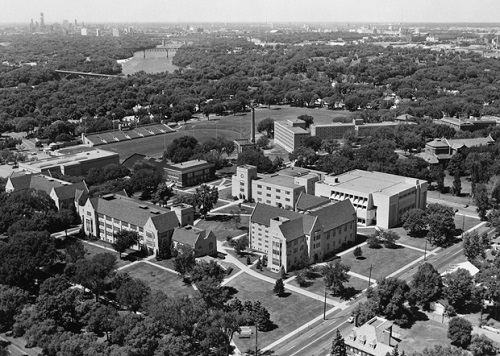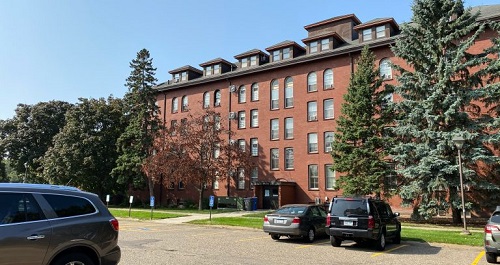A Brief History of the University of St. Thomas
 Monday, October 4, 2021 at 3:01AM |
Monday, October 4, 2021 at 3:01AM |  Michael Rainville Jr |
Michael Rainville Jr | Article by Michael Rainville, Jr.
The 2021-2022 school year is the beginning of a new era at the University of St. Thomas. For the first time in their 136-year history, the Tommies will participate in Division I of the NCAA in all sports. This unprecedented jump from Division III to I has put the spotlight on my alma mater, so let’s take a look at how St. Thomas became the university it is today.
 A 1886 print of the original building that previously housed the Catholic Industrial Boys School.
A 1886 print of the original building that previously housed the Catholic Industrial Boys School.
Starting with the history of the land, in 1805, the first governor of the Louisiana Territory, James Wilkinson, ordered Lieutenant Zebulon Pike to lead an expedition up the Mississippi River to explore the upper region of this new territory. Keep in mind that Wilkinson never informed the United States government of this expedition. Departing from St. Louis on August 9th, the expedition crew arrived at Bdote, the confluence of the Minnesota and Mississippi rivers, on September 21st. Here, Lt. Pike negotiated a treaty with seven Dakota leaders to acquire the land from Bdote up to Owamni, also known as St. Anthony Falls, as well as land around the confluence of the Mississippi and St. Croix rivers, a total of over 150,000 acres. Only two of the seven Dakota leaders signed the treaty, and since the U.S. government was never aware of the expedition, the treaty was illegal. In fact, in 1856, the Military Affairs Committee of the Senate noted in a report,
“It does appear that General Pike made an arrangement in 1805 with two Sioux Indians for the purchase of the lands of that tribe, including the Faribault island, but there is no evidence that this agreement, to which there is not even a witness, and in which no consideration was named, was ever considered binding upon the Indians, or that they ever yielded up the possession of their lands under it… It was never promulgated, nor can it be now found upon the statute books, like any other treaty—if indeed a treaty it may be called—nor were its stipulations ever complied with on the part of the United States.”
Nonetheless, the land that was included in the “treaty” was turned into a military reservation once Fort Snelling was established in 1819.
Almost thirty years later in 1848, William Finn, a veteran of the Mexican-American War and the namesake of Finn Street, was awarded a portion of this land; 640 acres along the east side of the Mississippi River, from modern-day Marshall Avenue to St. Clair Avenue and from Fairview Avenue to the river. This soon became known as Finn’s Farm, and in 1874, Bishop Thomas Grace of Saint Paul purchased 452 acres from Finn and established the Catholic Industrial School for boys whose family lives were disrupted by the Civil War.
In the 1880s, Archbishop John Ireland made it a priority to establish a Catholic seminary, a college that prepares students to become priests, in order to help assimilate the many new Catholic immigrants to the American way of life. The Diocese of St. Paul, known as the Archdiocese of Saint Paul and Minneapolis since 1966, renovated the old Catholic Industrial School and on September 8th, 1885, the St. Thomas Seminary opened its doors. This new school consisted of a high school, college, and seminary, and had a rector, five professors, who were also priests, and sixty-two students.
One of the first sporting events to happen at St. Thomas was a baseball game. The college fielded a team called the Shadow Falls Base Ball Club in 1886, named after the waterfall that empties into the Mississippi River right by the campus. The team joined the Minnesota Athletic Conference in 1902 and won the inaugural championship.
 Lake Mennith, 1907
Lake Mennith, 1907
During the early years of the campus, students could be seen sailing, and skating during the winter months, on a human-made pond known as Lake Mennith. It was created in 1887 when the school dammed a creek and wetland that went through the middle of campus. Lake Mennith was filled in when the City of Saint Paul installed a sewer line through campus in 1910.
In 1894, the liberal arts college was founded thanks to a donation by James J. Hill to establish the Saint Paul Seminary School of Divinity separately from the college. The funds were used to create multiple different buildings, including two dormitories, Loras and Cretin halls, a dining hall, library, chapel, and gymnasium and power plant. The architect in charge of the seminary’s new campus was Cass Gilbert, who also designed our State Capitol Building and the United States Supreme Court Building. Two of these structures still stand and many have been replaced.
 St. Thomas campus, 1930
St. Thomas campus, 1930
The most recent of these original buildings to be demolished is Loras Hall. This building was used for offices for the last years of its life and was razed this past spring to make way for a new STEAM building (science, technology, engineering, arts, and math). The original plan was for Loras Hall to be moved to the west a few dozen feet, but that plan fell through. The Saint Paul Historic Preservation Committee voted 6-1 to deny the university a demolition permit. However, after an appeal to the city council, the council voted 6-1 to allow demolition. This was quite heartbreaking and frustrating to see as someone who studied history and architecture at the university. Methods and theories of historic preservation that I was taught seemed to be ignored and not practiced by the university, ignoring the historic preservation committee’s ruling. I do look forward to touring the new STEAM building when it is completed in the coming decade.
One of the more famous buildings on St. Thomas’ campus is the chapel. Initially, services were held in the basement of the old administrative building, but as the student body population was growing, so was the need for a larger, separate space to worship. During the turn of the twentieth century, Archbishop Ireland was searching for a location for a new, much larger cathedral for the diocese, and he heavily considered a site across Cleveland Avenue from the college’s campus, where Laurel Flats Apartments now stand. He ended up going with the cathedral’s current location, at Summit and Selby avenues, and the college was still needing a larger place to worship.
The first chapel was constructed in 1907, but this wooden structure quickly became too small for the college. It was torn down in 1917 and was replaced with the current chapel, designed by Emmanuel Masqueray, the same architect who also designed the Cathedral of Saint Paul and Basilica of St. Mary in Minneapolis.
 Aerial photo of the campus in 1971 with downtown Minneapolis in the background to the left.
Aerial photo of the campus in 1971 with downtown Minneapolis in the background to the left.
Archbishop Ireland and college president Reverend Humphry Moynihan worked to establish St. Thomas as a military school in the early 1900s, and in 1905, they had a contract with the U.S. War Department to start that process. The college was designated as a military academy in 1907, and the next year, it ranked in the top ten of all military academies in the nation. Military training was required for all students until 1922 when students were allowed to opt out of the training. Students who joined the college from its high school, St. Thomas Academy, were still required to participate in training.
St. Thomas started its first graduate program in 1950, education, and its second in 1974, business administration. In 1977, they became co-educational, and in 1990, St. Thomas College changed its name to the University of St. Thomas. In 1991, they opened their downtown Minneapolis campus, and ten years later in 2001, their School of Law moved to that location.
 Photo of Loras Hall taken in 2020 by Casey Eakins of Tommie Media.
Photo of Loras Hall taken in 2020 by Casey Eakins of Tommie Media.
The University of St. Thomas has a long, storied past, and their future looks brighter than ever, becoming just the second school in Minnesota to participate in Division I athletics in all sports. The university is growing in every sense, and I couldn’t be prouder to be a Tommie. Roll Toms!
- - - - - - - - - - - - - - - - - - - - - - - - - - - - - - - - - - - - - - -
 About Michael Rainville, Jr.
About Michael Rainville, Jr.
A 6th generation Minneapolitan, Michael Rainville, Jr. received his B.A. in History, Graduate Certificate in Museum Studies, and M.A. in Art History from the University of St. Thomas.
